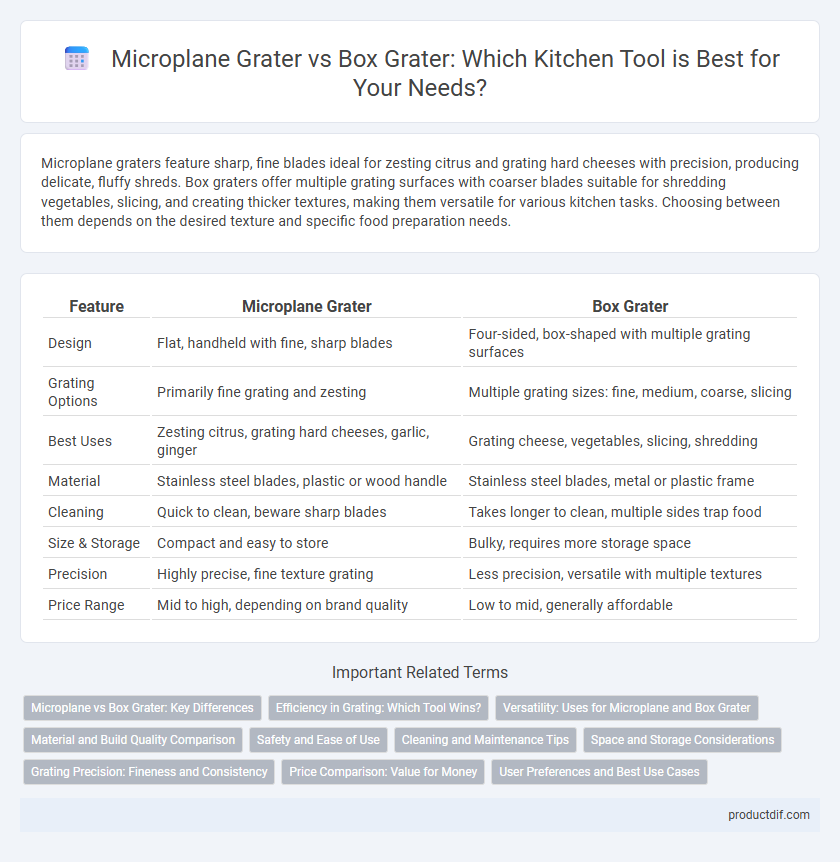Microplane graters feature sharp, fine blades ideal for zesting citrus and grating hard cheeses with precision, producing delicate, fluffy shreds. Box graters offer multiple grating surfaces with coarser blades suitable for shredding vegetables, slicing, and creating thicker textures, making them versatile for various kitchen tasks. Choosing between them depends on the desired texture and specific food preparation needs.
Table of Comparison
| Feature | Microplane Grater | Box Grater |
|---|---|---|
| Design | Flat, handheld with fine, sharp blades | Four-sided, box-shaped with multiple grating surfaces |
| Grating Options | Primarily fine grating and zesting | Multiple grating sizes: fine, medium, coarse, slicing |
| Best Uses | Zesting citrus, grating hard cheeses, garlic, ginger | Grating cheese, vegetables, slicing, shredding |
| Material | Stainless steel blades, plastic or wood handle | Stainless steel blades, metal or plastic frame |
| Cleaning | Quick to clean, beware sharp blades | Takes longer to clean, multiple sides trap food |
| Size & Storage | Compact and easy to store | Bulky, requires more storage space |
| Precision | Highly precise, fine texture grating | Less precision, versatile with multiple textures |
| Price Range | Mid to high, depending on brand quality | Low to mid, generally affordable |
Microplane vs Box Grater: Key Differences
Microplane graters are known for their ultra-sharp, fine blades that effortlessly create zest, finely shredded cheese, or garlic with precision, while box graters offer multiple coarse to fine grating surfaces ideal for versatility. The ergonomic design of Microplanes provides better control and reduces effort compared to the bulkier, multi-sided box grater that often requires more force and can be less comfortable for prolonged use. Microplane graters excel in producing uniform, delicate textures, making them preferred for tasks demanding finesse, whereas box graters are better suited for larger, varied grating jobs in the kitchen.
Efficiency in Grating: Which Tool Wins?
Microplane graters excel in efficiency with ultra-sharp, fine blades that effortlessly shred zest, cheese, and spices with minimal effort and maximum precision. Box graters offer versatility with multiple grating surfaces but require more force and time to achieve similar results, often producing uneven textures. For rapid, precise, and consistent grating efficiency, Microplane tools dominate in professional and home kitchens.
Versatility: Uses for Microplane and Box Grater
Microplane graters excel in finely zesting citrus, grating hard cheeses like Parmesan, and creating delicate spice powders such as nutmeg, making them ideal for precision tasks. Box graters offer versatility with multiple grating surfaces, allowing shredding of vegetables, slicing cheese, and coarse grating, which suits a broader range of kitchen preparations. Choosing between Microplane and box graters depends on the required texture and variety of food items to be processed in cooking.
Material and Build Quality Comparison
Microplane graters feature high-carbon stainless steel blades renowned for long-lasting sharpness and resistance to rust, ensuring effortless grating and fine zesting. Box graters are typically constructed from stainless steel with a thicker, more rigid frame that provides stability but may dull faster over time due to broader, less precise grating surfaces. The build quality of Microplane graters emphasizes precision and ergonomics, while box graters prioritize versatility with multiple grating options in a single durable unit.
Safety and Ease of Use
Microplane graters feature sharp, precision-etched blades that require careful handling but offer superior ease of use with minimal effort and consistent results. Box graters provide a sturdy grip and multiple grating surfaces, enhancing safety by reducing the risk of slipping but can be more cumbersome to maneuver. Both tools demand attention to finger placement, yet Microplanes often promote safer grating speed due to their ergonomic design and reduced surface area contact.
Cleaning and Maintenance Tips
Microplane graters feature fine, sharp teeth that minimize food buildup, making them easier to clean with a soft brush and warm soapy water. Box graters often trap food particles in their multiple grating surfaces, requiring thorough rinsing and occasional use of a toothpick or scrub brush for effective cleaning. Both types benefit from drying immediately after washing to prevent rust and maintain sharpness.
Space and Storage Considerations
Microplane graters offer a slim, compact design ideal for kitchens with limited counter and storage space, easily fitting into drawers or utensil holders. Box graters, while bulkier and more versatile with multiple grating surfaces, require more storage room due to their three- or four-sided structure. Choosing a Microplane grater optimizes space efficiency, especially in small kitchens or for minimalistic setups.
Grating Precision: Fineness and Consistency
Microplane graters excel in grating precision with ultra-fine, consistently sharp blades that produce delicate, fluffy results ideal for zesting citrus or grating hard cheeses. Box graters offer multiple grating surfaces but often deliver less uniformity, with coarser blades suitable for larger shreds and more robust tasks. The Microplane's design ensures finer, more consistent grating that enhances texture and flavor integration in culinary applications.
Price Comparison: Value for Money
Microplane graters typically offer superior sharpness and durability at a higher price point compared to box graters, making them a worthwhile investment for frequent use. Box graters are generally more affordable and multifunctional but may lack the precision and long-lasting edge of Microplane models. Evaluating cost against performance, Microplane graters deliver better value for money in tasks requiring fine grating and consistent results.
User Preferences and Best Use Cases
Microplane graters excel in producing finely grated zest, cheese, and spices, favored by users seeking precision and delicate texture. Box graters offer versatility with multiple grating surfaces, ideal for shredding, slicing, and coarse grating in larger quantities, preferred by cooks handling diverse kitchen tasks. User preference depends on task specificity: Microplane for fine grating and quick zesting; box grater for multifunctional use and bulk preparation.
Microplane grating vs Box grating Infographic

 productdif.com
productdif.com